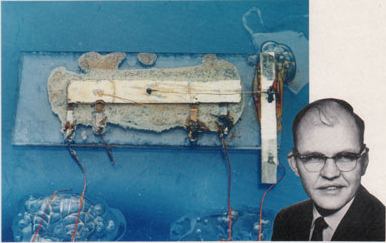Sept. 12, 1958: Kilby Chips In, Integrates Circuit
 Sept. 12, 1958: Kilby Chips In, Integrates Circuit
Sept. 12, 1958: Kilby Chips In, Integrates Circuit
"1958: New hire Jack Kilby shows his Texas Instruments colleagues a little something he's built. A very little something: a working integrated circuit on a piece of semiconductor material. The world will soon change."
Electronics had relied on vacuum tubes for half a century before Bell Labs invented the transistor in 1947. Transistors were tinier, more reliable, longer-lasting, cooler and more energy-efficient. But connecting hundreds or thousands of them in a complex circuit required wire and solder. That cost money, took time and created thousands of ways for the circuit to fail.

IC
It forms an component used today in every Hardware used.So it is appropriate to start with the small yet Powerful IC.Only a half century after their development was initiated, integrated circuits have become ubiquitous. Computers, cellular phones, and other digital appliances are now inextricable parts of the structure of modern societies. That is, modern computing, communications, manufacturing and transport systems, including the Internet, all depend on the existence of integrated circuits. Indeed, many scholars believe that the digital revolutionóbrought about by the microchip revolutionówas one of the most significant occurrences in the history of humankind.
Types
Integrated circuits can be classified into analog, digital and mixed signal (both analog and digital on the same chip).
Digital integrated circuits can contain anything from a few thousand to millions of logic gates, flip-flops, multiplexers, and other circuits in a few square millimeters. The small size of these circuits allows high speed, low power dissipation, and reduced manufacturing cost compared with board-level integration. These digital ICs, typically microprocessors, DSPs, and micro controllers work using binary mathematics to process "one" and "zero" signals.
Analog ICs, such as sensors, power management circuits, and operational amplifiers, work by processing continuous signals. They perform functions like amplification, active filtering, demodulation, mixing, etc. Analog ICs ease the burden on circuit designers by having expertly designed analog circuits available instead of designing a difficult analog circuit from scratch.
ICs can also combine analog and digital circuits on a single chip to create functions such as A/D converters and D/A converters. Such circuits offer smaller size and lower cost, but must carefully account for signal interference.
Notable ICs
The 555 common multi-vibrator sub-circuit (common in electronic timing circuits)
The 741 operational amplifier
7400 series TTL logic building blocks
4000 series, the CMOS counterpart to the 7400 series
Intel 4004, the world's first microprocessor
The MOS Technology 6502 and Zilog Z80 microprocessors, used in many home computers
Electronics had relied on vacuum tubes for half a century before Bell Labs invented the transistor in 1947. Transistors were tinier, more reliable, longer-lasting, cooler and more energy-efficient. But connecting hundreds or thousands of them in a complex circuit required wire and solder. That cost money, took time and created thousands of ways for the circuit to fail.

IC
It forms an component used today in every Hardware used.So it is appropriate to start with the small yet Powerful IC.Only a half century after their development was initiated, integrated circuits have become ubiquitous. Computers, cellular phones, and other digital appliances are now inextricable parts of the structure of modern societies. That is, modern computing, communications, manufacturing and transport systems, including the Internet, all depend on the existence of integrated circuits. Indeed, many scholars believe that the digital revolutionóbrought about by the microchip revolutionówas one of the most significant occurrences in the history of humankind.
Types
Integrated circuits can be classified into analog, digital and mixed signal (both analog and digital on the same chip).
Digital integrated circuits can contain anything from a few thousand to millions of logic gates, flip-flops, multiplexers, and other circuits in a few square millimeters. The small size of these circuits allows high speed, low power dissipation, and reduced manufacturing cost compared with board-level integration. These digital ICs, typically microprocessors, DSPs, and micro controllers work using binary mathematics to process "one" and "zero" signals.
Analog ICs, such as sensors, power management circuits, and operational amplifiers, work by processing continuous signals. They perform functions like amplification, active filtering, demodulation, mixing, etc. Analog ICs ease the burden on circuit designers by having expertly designed analog circuits available instead of designing a difficult analog circuit from scratch.
ICs can also combine analog and digital circuits on a single chip to create functions such as A/D converters and D/A converters. Such circuits offer smaller size and lower cost, but must carefully account for signal interference.
Notable ICs
The 555 common multi-vibrator sub-circuit (common in electronic timing circuits)
The 741 operational amplifier
7400 series TTL logic building blocks
4000 series, the CMOS counterpart to the 7400 series
Intel 4004, the world's first microprocessor
The MOS Technology 6502 and Zilog Z80 microprocessors, used in many home computers

Soleil- Number of posts : 8
Age : 35
Location : Pune
Branch : Electronics and Telecommunications
Registration date : 2008-08-22
Permissions in this forum:
You cannot reply to topics in this forum

